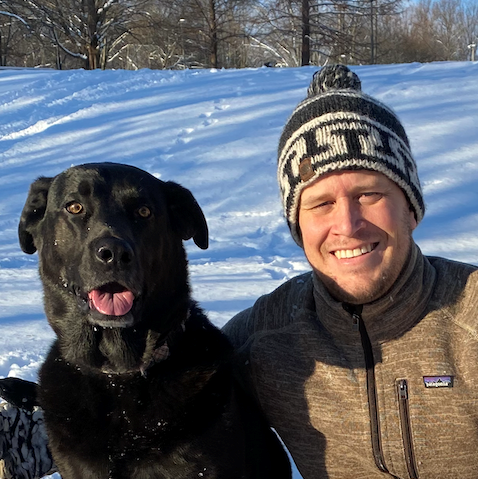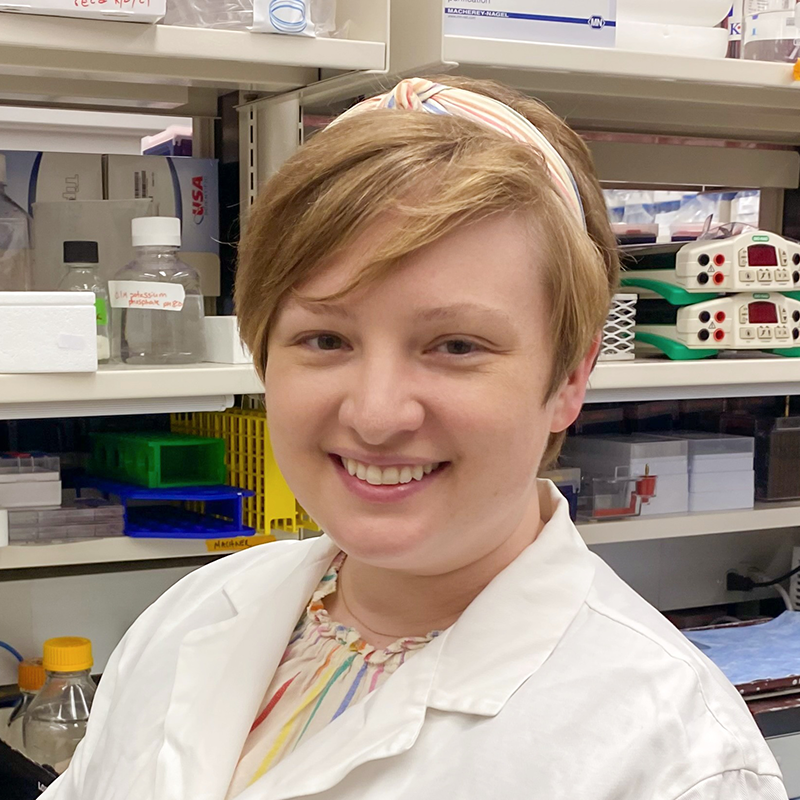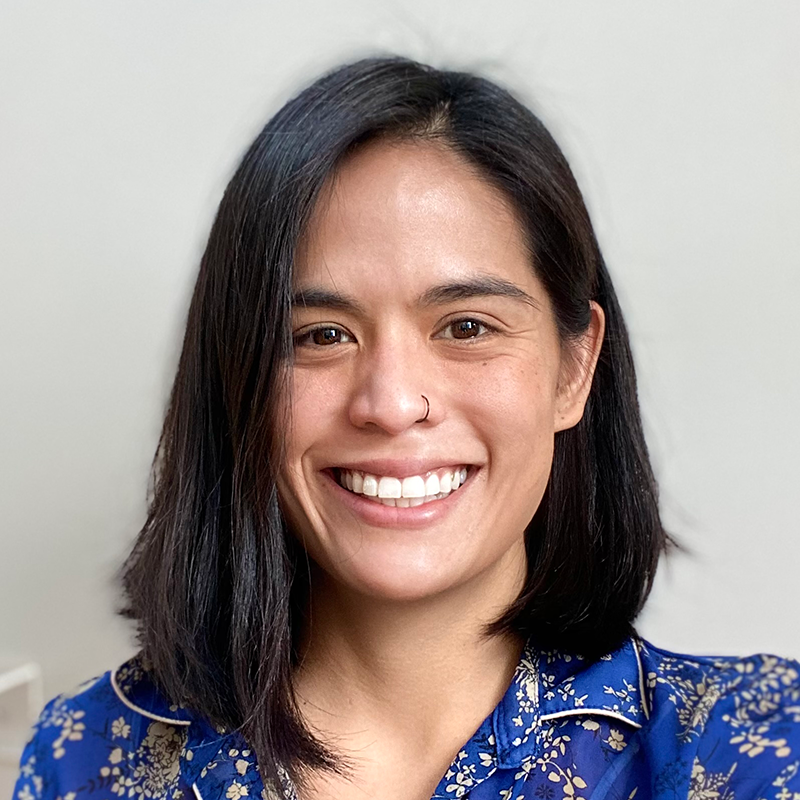Learning how to secure research funding is integral to becoming an independent investigator. The Intramural Research Fellowship (IRF) is a competitive research funding opportunity for NICHD postdoctoral, visiting, and clinical fellows. Its main objective is to promote grant writing among intramural trainees, while enhancing awareness of the various components of an NIH grant application.
To learn more about what it takes to write a winning grant application, we asked this year’s IRF recipients about their experiences applying for the IRF grant and what this award has meant for their careers. Read below to hear from this year’s winners: Joyce Thompson, Jennifer Panlilio, Stephanie Lehman, and Paul Atkins.

Paul Atkins, PhD, is a postdoctoral fellow in Dr. Henry Levin’s laboratory, the Section on Eukaryotic Transposable Elements. Dr. Atkins studies the structure and organization of rDNA repeats in fission yeast.

Stephanie Lehman, PhD, is a postdoctoral fellow in Dr. Matthias Machner’s laboratory, the Section on Microbial Pathogenesis. Dr. Lehman characterizes how Legionella pneumophila, the causative agent of Legionnaire’s disease, uses a secreted effector protein to hijack the host proto-oncoprotein NRas to dampen host signaling and promote infection.

Jennifer Panlilio, PhD, is a postdoctoral fellow in Dr. Harold Burgess’ laboratory, the Section on Behavioral Neurogenetics. Dr. Panlilio seeks to identify the neurons that regulate arousal in response to environmental cues by examining fish behavior. Her broader aim is to learn how arousal is controlled and dysregulated in disease.

Joyce Thompson, PhD, is a postdoctoral fellow in Dr. Pedro Rocha’s laboratory, the Unit on Genome Structure and Regulation. Dr. Thompson’s goal is to understand how lineage-determining transcription factors interact with multiple layers of the chromatin to drive diversification of distinct lineages from common progenitors during early mammalian embryogenesis.
What is your top grant writing tip?
Paul Atkins (PA): Communicate your goals with the least amount of information possible but ensure the information you do include is as clear as you can make it.
Stephanie Lehman (SL): Especially for the internal grants here at the NIH, your audience is often not going to be an expert in your field. Your grant has to be super simple and super clear. Have lots of other people read it who are not in your lab (at least your Specific Aims page) and see what parts they didn’t quite follow. Pay attention to where they ask questions and workshop those sentences over and over. Sometimes you have to adjust your writing a lot to account for something you assumed a reader would understand, but they didn’t.
Another tip: if your grant(s) don’t get funded, a lot of times I think it’s luck of the draw with the reviewer you got. So, yes, you need great research and clear writing, but you might also just need more volume . You need to get your proposal out there more and more to as many funding opportunities as you can until you can hit upon the right set of reviewers who both see the value of your work and advocate strongly for you in the study section.
Jennifer Panlilio (JP): Ask for feedback from a variety of colleagues—from scientists with expertise in your grant topic to those outside your field. Together, they will be able to provide balanced feedback. Scientists outside your field will flag unnecessary jargon and push you to think about the broader implications of your work. Those within your field will have the technical expertise to challenge your approach and suggest alternatives.
Joyce Thompson (JT): Make it easy to read and use white space!
What challenge did you encounter while writing the grant application and how did you overcome it?
PA: Finding the right “level” for the target audience is always the most difficult part of writing for me. The workable space between arcane and superficial can be surprisingly narrow. Back-and-forth with my mentor, Dr. Henry Levin, helped me find the right level. Also, taking a week or so break then revisiting helped me get a fresh perspective on my writing.
SL: I had comments from previous grant reviewers that highlighted some misunderstandings about the purpose of my field of research in general. At first it seemed to me that I should not have to spend a lot of text to justify why our field of study exists, as I thought a reviewer in my field would understand the value of this type of work. But I realized that to someone far outside my field (as is the case for reviewers of many grants), I really couldn’t take it for granted that they would understand. It was very challenging to try to expand even more than I usually do on why our field of science is critical in such a short space, while also trying to convey enough background information, data, and experimental design concepts. But it was the most important thing I could spend time on and make space for!
JP: I found it most challenging to propose a set of ideas that were innovative, yet doable within the short timeline the grant funds. I had a broad set of goals for my project, aims that address these goals, and specific strategies/approaches to achieve these aims. I mapped out the experiments on a timeline. I prioritized exciting experiments of which I had preliminary data and knew I could accomplish within the time frame of the grant. If I was proposing to use a novel technique of which I had limited experience and preliminary data, I looked for colleagues who were well-versed in the technique I was proposing. This way, I knew that the experiments I was proposing were doable within the short time frame of the IRF.
JT: One of the major challenges I always face is to write less. We often have so many ideas we want to pursue that we lose sight of which of those are most likely to be accomplished in the timeframe allowed by the grant. Often my final grant is cut down to a third of the experiments that I proposed in my first draft. Asking my PI and peers to point out what aims are outrageously ambitious helped me a lot.
Another challenge I always face is to write accessibly. What I write in my first draft is often not easy to understand for someone outside my lab or my research area. To overcome this, I ask people outside my field to read my draft.
How did this grant writing experience influence or prepare you for your future career goals?
PA: This was great practice breaking down a broad project into digestible pieces that can be readily conveyed.
SL: This is the first time I’ve had a grant application successfully receive funding (I’ve written six now), so it was huge in helping build my confidence that I can both do and convey important research. This grant will help me on the path to leading my own research group.
JP: I am still figuring out my next steps but learning to seek feedback from key people in the field, prioritize ideas, develop budgets, and ultimately develop a cohesive piece are all key skills that I will take with me in my future career.
JT: I learned how to budget my time effectively. It also helped me discipline myself and inculcated a habit of working on a draft much ahead of the deadline (greater than three months), so I had enough time to get good feedback and tweak my application.
What was the most helpful resource you encountered while preparing your grant application?
PA: My mentor Dr. Henry Levin gave me several rounds of invaluable feedback that dramatically improved the application.
SL: BioRender! While I don’t know how the reviewers felt about the figures, it was helpful to make clear figures. I had enough room for three figures: a cartoon to summarize my project with some key data, and a graphical abstract-style figure for each of my aims (including key data and the broad questions I was addressing). Everyone I spoke to thought it was very helpful to see the content visualized in an infographic-type style. I’m a very visual learner too, so this helped me organize the way I wrote the text more clearly.
JP: Previous successful IRF and trainee applications provided me with a great scaffold. Through these proposals, I got a better sense for the research scope, writing style, and formatting.
JT: The best resource I found was reading successful grant applications and comparing it to my previous grants that scored poorly. I was able to change my application style based on what is generally funded.
Funding Opportunities for Intramural Fellows
Having trouble finding grant opportunities as an intramural fellow, or you’re not sure what you are eligible for while working for a federal agency?
The NICHD Office of Education invites you to explore our “Funding Opportunities” on the NICHD fellows’ wiki page.
We compiled a list of organizations that accept applications from NIH intramural fellows, both NIH and non-NIH funding mechanisms. Plus, we indicate if the grant can be awarded to a non-US citizen.
This valuable resource could jump start your grant search. We will update the webpage as we continue to vet other funding opportunities.
